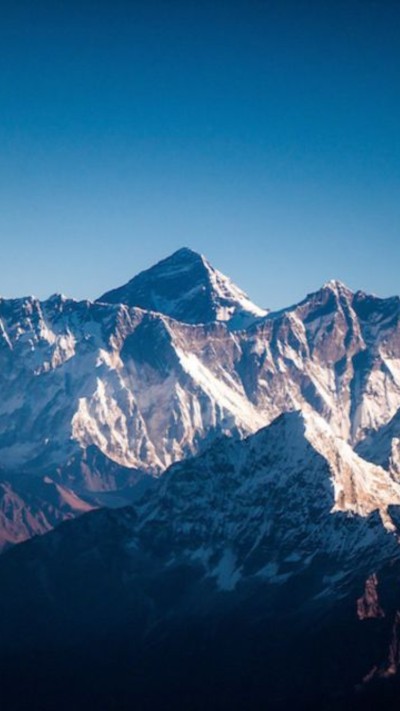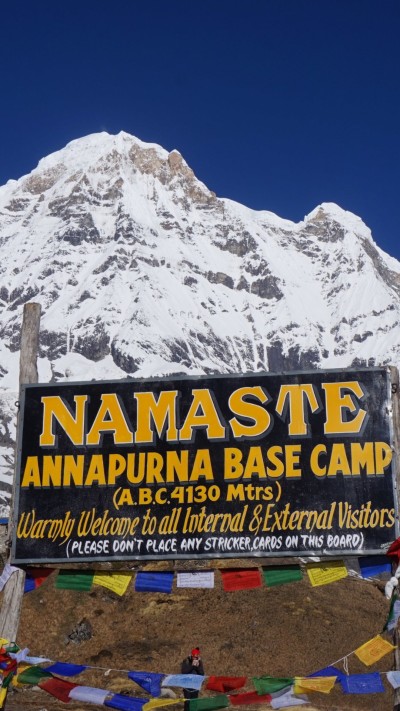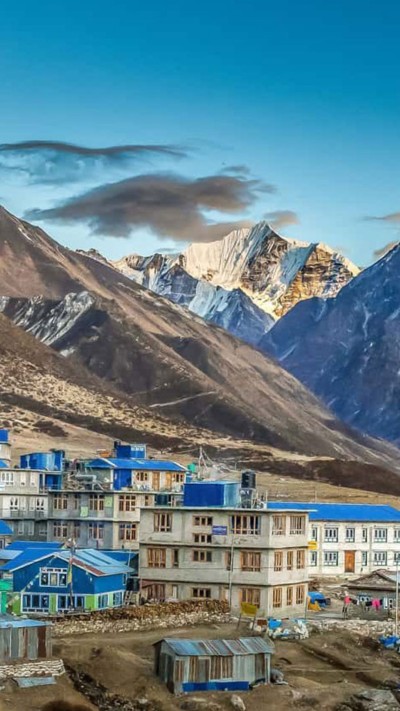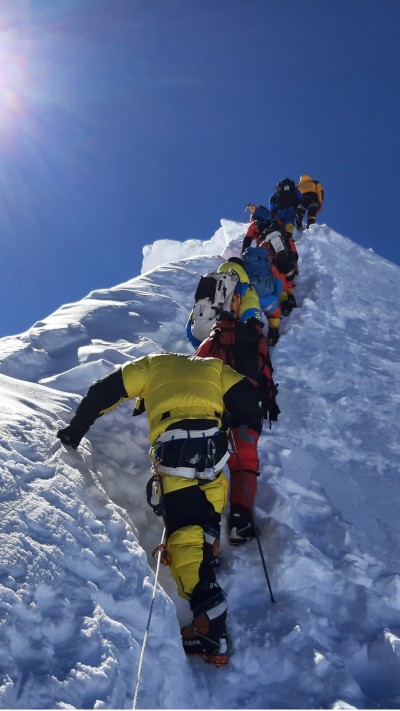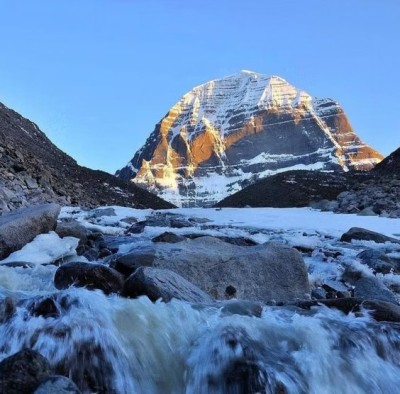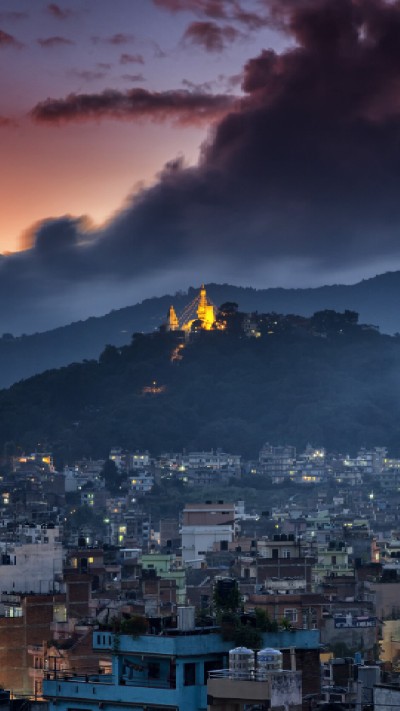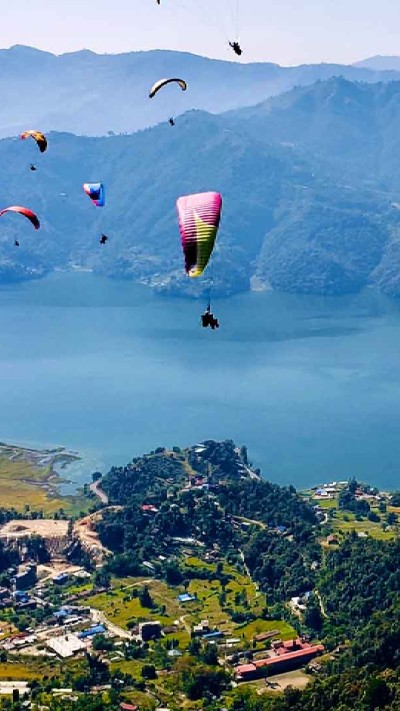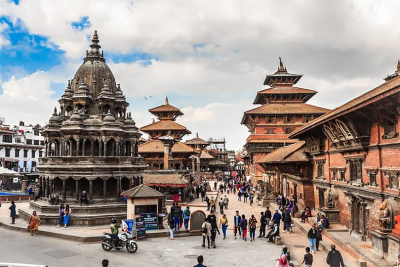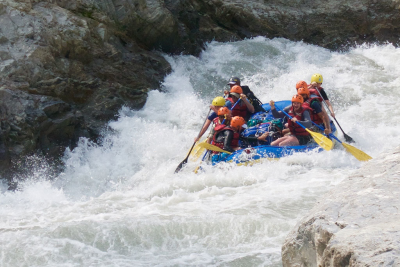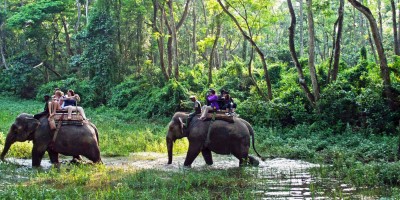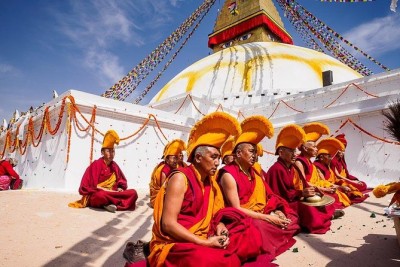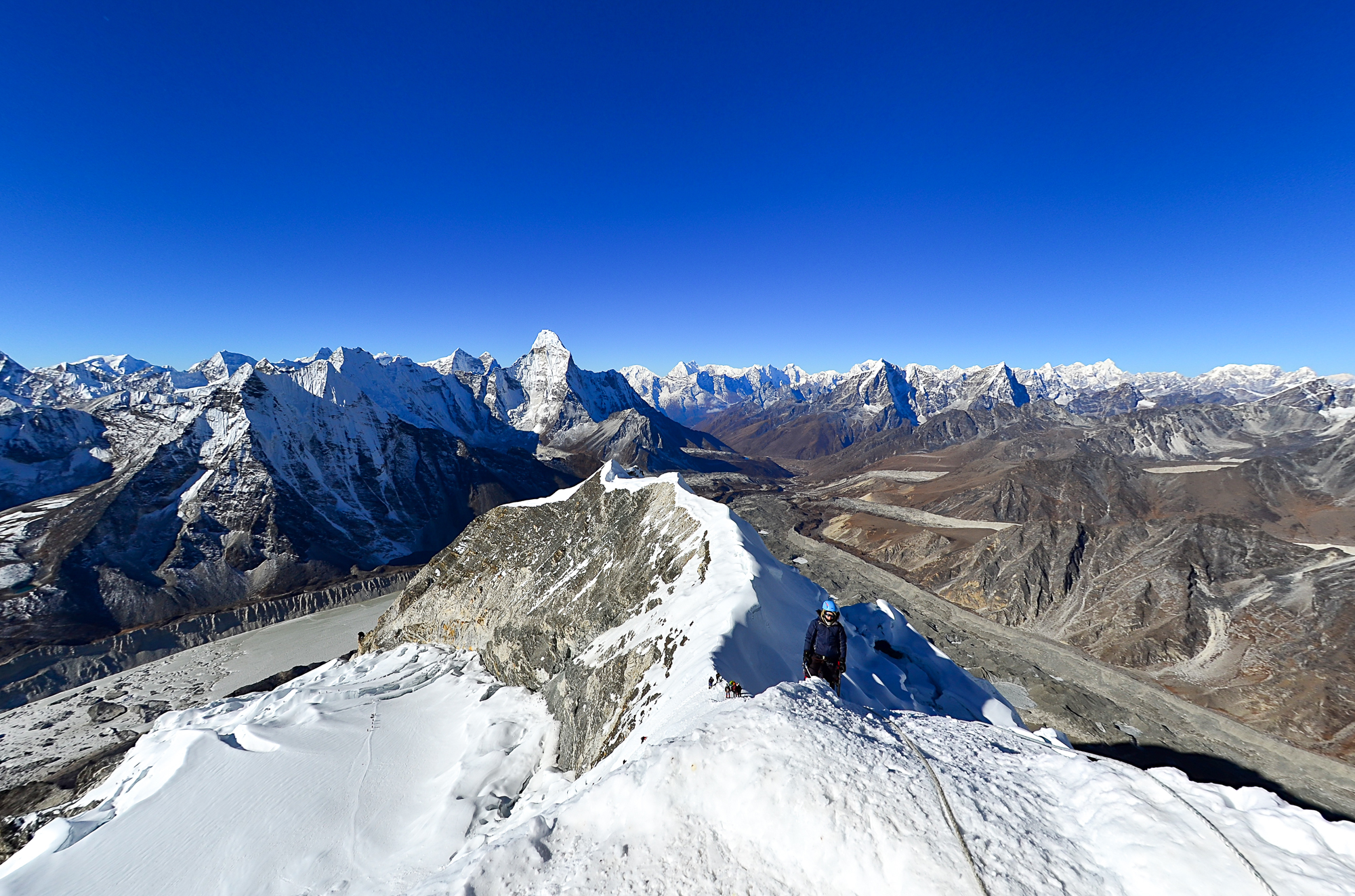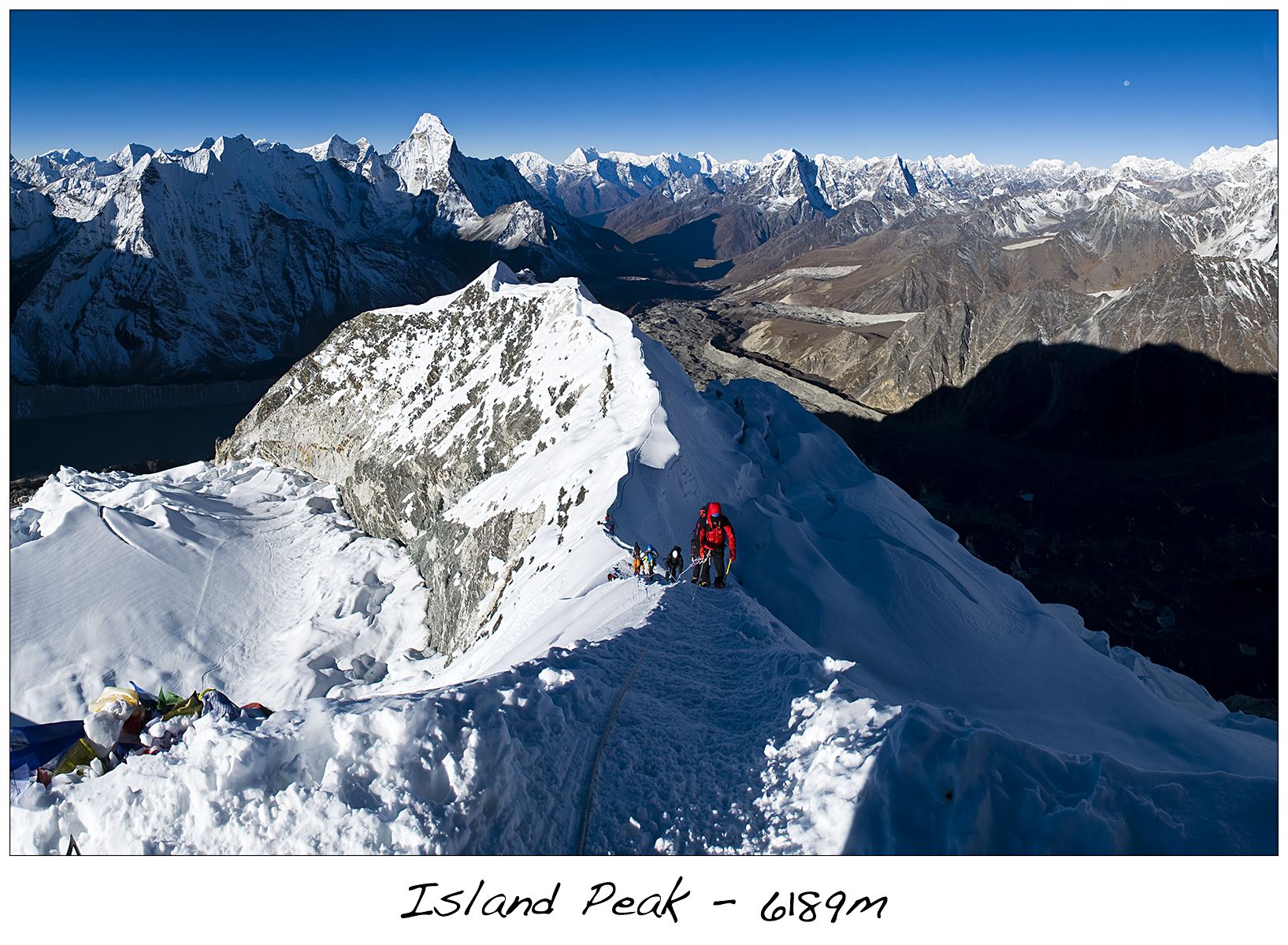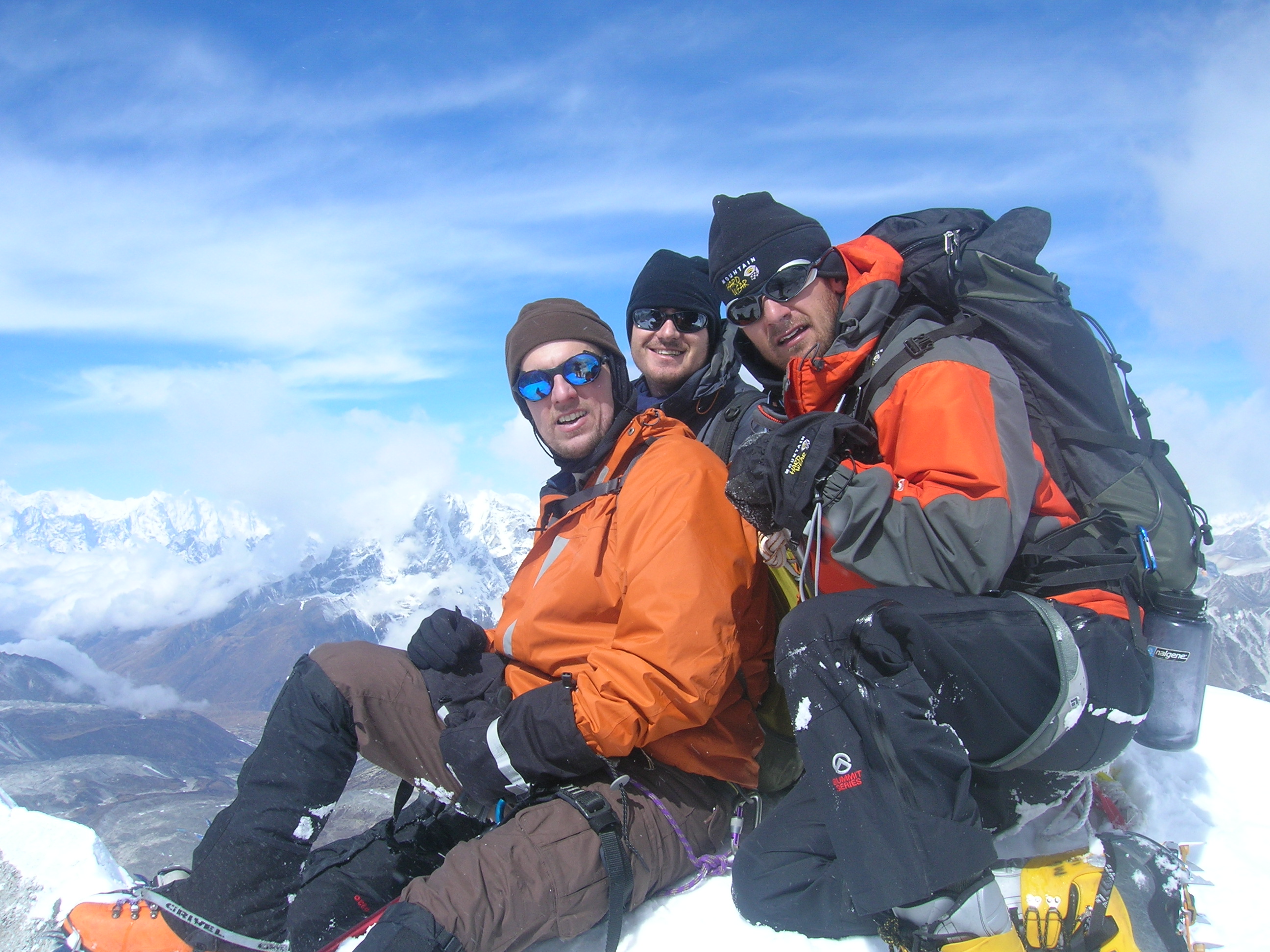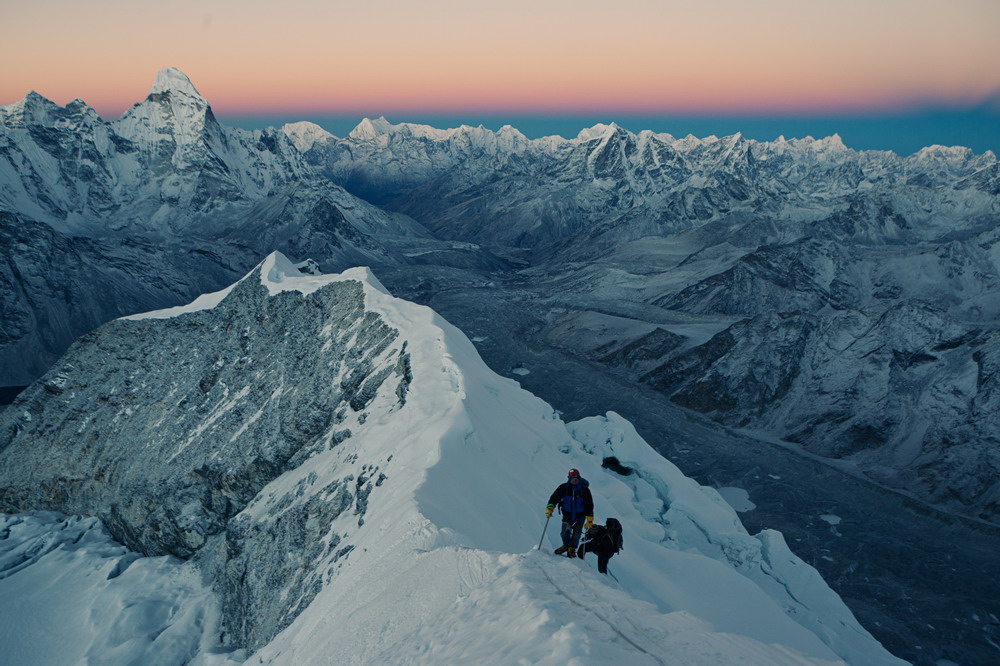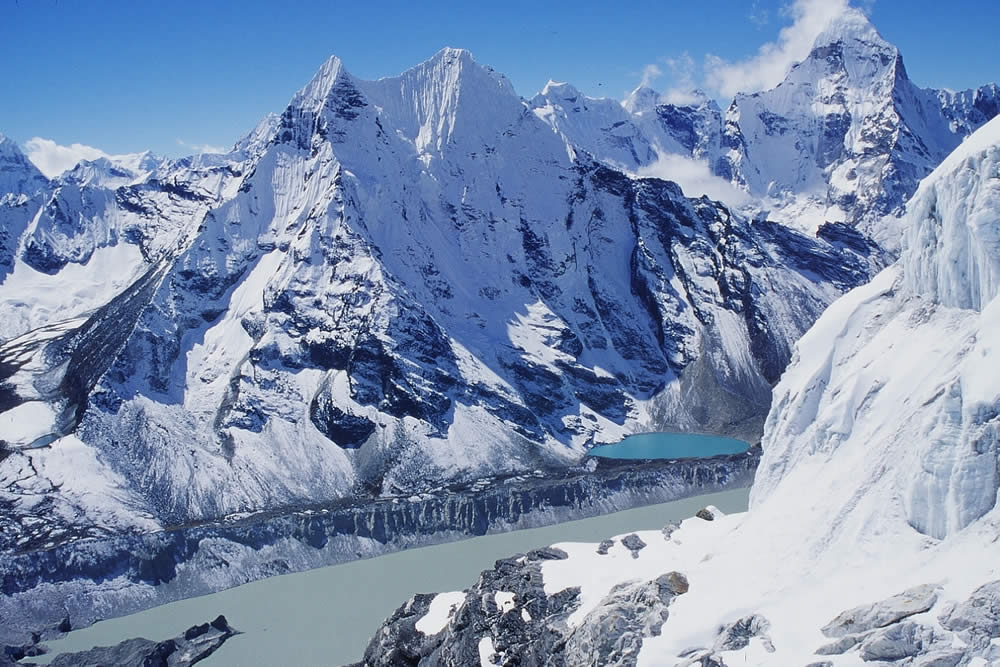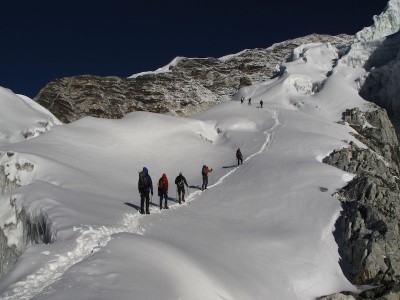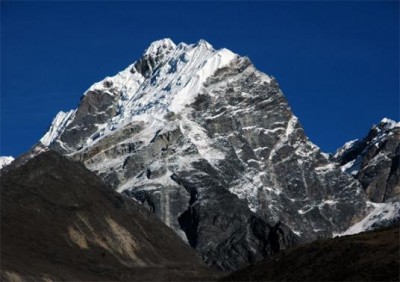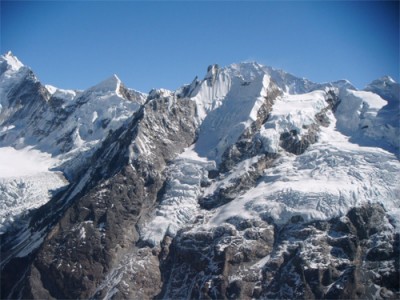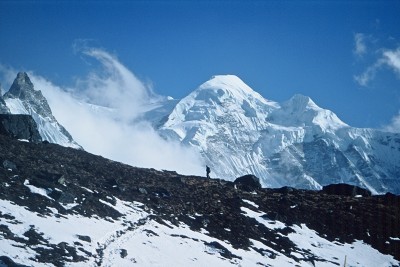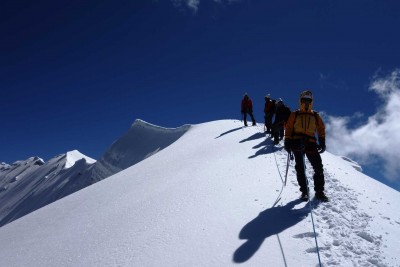Island Peak Climbing
Island Peak offers stunning panoramic views and the opportunity it provides for adventurous climbers to summit a peak.
Highlights of Island Peak Climbing
- Experience the exhilaration of trekking to Everest Base Camp.
- Trek up to 6183m through spectacular scenery.
- Trek through the heart of Sherpa country.
- Informative guides to uncovering the history behind mystical sights
- Breathtaking views of the Everest region
- Get to know the gentle spirit of the Sherpa people.
- Everest, Lhotse, Nuptse, Changtse, Ama Dablam, and scores of other lesser crests seen from a peaked vantage point
- Get among the hustle and bustle of the market town of Namche Bazaar.
- A guided tour of Kathmandu’s ancient temples
Overview
Island Peak, also known as Imja Tse, is one of the most popular trekking peaks in Nepal for climbing in the Himalayas. The combination of the Everest Base Camp Trek and Island Peak climbing is probably the best trip in Nepal, adored by adventure seekers. Imja Tse not only provides an enjoyable climb but also provides some of the most spectacular scenery of the Himalayas in the Everest region. Seen from the summit, the giant mountains of Nuptse (7,879m), Lhotse (8,501m), Lhotse Middle Peak (8,410 m), and Lhotse Shar (8,383m) make a semi-circle in the north. The views of Makalu (8475m) in the east, Baruntse, and Amadablam in the south add more charm to climbing Island Peak. For many mountaineers, climbing Island Peak marks the beginning of climbing in the Himalayas to prepare for a big Himalaya expedition in Nepal in the later years.
Getting to and from Island Peak
Our excursion starts with a 40-minute' trip to Lukla from Kathmandu. Upon appearance, we will prepare and travel to Phakding, where we will spend the rest of the day visiting nearby religious communities. The following day, we journey to Namche Bazaar, where we will go through a day of acclimatization. We will additionally proceed with the journey to Tengboche, then Dingboche to Chhukung. From here, the path goes upwards the high Imja valley, and lastly to the base camp of Island Peak's south edge, from where we will see striking perspectives underneath the Nuptse-Lhotse wall. The following day, we culminated at Island Peak. We start the highest point day early in the morning scrambling along a stone edge to an ice sheet. Over the stone edge there is a precarious snow head divider prompting the summit. From the pinnacle you will be compensated with staggering, strange perspectives on mountains Nuptse (7,879m), Lhotse (8,501m), Lhotse focal (8,410 m), and Lhotse Shar (8,383 m), which structure a semi hover in the north, and the shocking perspectives on Makalu (8475m), Baruntse (7129 m), and the well-known endeavor pinnacle of Amadablam (6812m). You will be left with a sense of achievement that will last a lifetime. Next, we slide down and remember our travel trail for our arrival excursion to reach Lukla. This energizing experience of ascending a trip at Island Peak Climbing with Everest Base Camp finishes with a brain-catching grand mountain departure from Lukla back to Kathmandu.
This ascension is the tenderfoot's means to up to mountaineering undertakings for apprentice mountain dwellers who might be enthused about slope walkers with past mountaineering experience utilizing crampons and ice hatchets.
Show more...Outline Itinerary ( 19 Days ) Expand all +
Upon reaching Kathmandu, our representative will greet you at the airport, providing a warm welcome before transferring you to your hotel. Use this day to acclimate to the new time zone and dive into the vibrant atmosphere of kathmandu. An orientation program is scheduled for 5 pm to help to get acquainated with your surroundings.
Show more...
Following breakfast, our knowledgeable tour guide from Himalayan Social Journey will escort you on a captivating journey to explore Nepal's UNESCO-listed world heritage sites. Today's itinerary includes visits to the renowned Pashupatinath temple, the majestic Bouddhanath stupa, the tranquil Swoyambhunath Stupa and the historicPatan Durbar Square.
Show more...
Today marks the commencement of our adventure towards our destination. We will catch an early flight to Lukla and be greeted by breathtaking mountain vistas upon arrival. Our trek kicks off towards Phakding, where we''ll traverse through enchanting pine forests and charming Sherpa communities. As we reach the delightful village of phakding, we''ll settle into a cozy tea house for the night, utilizing the remaining daylight to wander and absorb the beauty of phakding. We''ll conclude the day with a fulfilling dinner at the teahouse.
During peak season (March, April, May, October, and November), flights to Lukla operates from Ramechhap/Manthali. Manthali is around 5 to 6 hours' drive from Kathmandu. In non-peak seasons (January, February, June, July, August, September, and December), flights to lukla operates from Kathmandu.
Overall, the decison to operate Lukla flights from Kathmandu or Ramechhap depends upon the weather and traffic flow. This diversion soley depends on the airlines, with the primary goal of ensuring safety and efficiency of trekkers.
Show more...
The trek from Phakding to Namche Bazar involves a scenic joureny through the Everest region. We'll traverse along the Dudh Koshi river,cross suspension bridges, and pass through picturesque sherpa village like Monjo. Ascend gradually through forest until reaching Namche Bazar, the bustling gateway to Everest.
Show more...
Prepare for a successful trek to Everest Base Camp. Begin by embracing acclimization, crucial for altitude adjustment. Namche Bazar offers the perfect setting for this. Today, pritorize relexation and exploration, allowing our body to adapt to higher altitudes. Enhance acclimization with a brief hike to Everset View Hotel. Spend the afternoon immersing in the charm of Namche Bazar and its Sherpa Museum. Stay hydrated throughout the day, savoring local Sherpa cuisine for dinner. Ensure a restful night's sleepp by retiring early.
Show more...
From here, we ascend towards Tengboche village, offers them with the first view of Everest itself. We can only see the tip, but the feeling is somewhere between cool and surreal. To know we're looking at the highest place on Earth. We will also be greeted with Tengboche Monastery of Dawa Choling Gompa. Visitors to Tengboche are permitted to walk freely about the monastery grounds, and they can even get a peak inside during certain hours. Check into a tea house for over night-stay and have a dinner and good sleep.
Show more...
After staying overnight in Tengbouche, we head to Dingboche in the morning. Our trail descends and passes through lush forests of birch, conifer, and rhododendron trees. While trekking, we can admire good views of Mt. Everest, Lhotse, and Ama Dablam. We continue our walk to the Imja Valley and Lobuche River before ascending to Dingboche. Later day we will be enjoy a stunning view of Ama Dablam.Check into a tea house for diiner and good sleep.
Show more...
As we journey from Dingboche to Lobuche, our path towards our destination draws nearer. The rugged terrain intensifies with each step, and the air grows thinner as we navigate the high- altitude landscape. Our day begins with a hearty breakfast, followed by preparation for the trek. We ascend towards Thukla pass, where breathtaking vistas of Punori and Nuptse await us. After a rejuvenating break in Thukla, we press onward towards Lobuche. Upon reaching our destination, we settle into a cozy tea house for the night, enjoying a satisfying dinner and before retiring for some well- deserved rest.
Show more...
Begin morning adventure from Lobuche after a hearty breakfast, traverse rugged terrain as we ascend towards Gorakshep, the final settlement before reaching Everest Base Camp. Take a brief break at a tea house for lunch, then set off on the exhilarating journey to Everest Base Camp, navigating the Khumbu Glacier.After soaking in the awe-inspiring experience at Everest Base Camp, trek them back to Gorakshep, where we can enjoy a delicious dinner at the tea house and retire early for a well-deserved rest.
Show more...
Ascend verticrtically behold the majesctic summit Pumori(7, 145m), Khumbuste (6,623m), Lingtren (6,697 m) and beyond delineating the border between Nepal and TIbet, all visible from the elevated vanatge point of Lho Lho pass. Marvel at the captivating panaroma including the enchanting landscapes of Changaste (7,750 m) before retracing our step back to Lobuche , encapsulating an unforgettable journey amidst nature's grandeur.
Show more...
The trek back to Dingboche offers breathtaking views of the Khumbu valley and its surrounding peaks, including Ama Dablam and Thamserku. Descending from Lobuche, the trail gradually winds through rocky terrain and glacial moraines, providing glimpses of the rugged beauty of the Himalayas. Finally, upon reaching Dingboche, you'll be greeted by the familiar sight of its stone houses and fields, providing a sense of accomplishment ana a chance to rest and rejuvenate before continuing your trek in the khumbu region.
Show more...
Trekking to Chukkung from dingboche is a scenic and relatively short hike in the Everest region of Nepal. The trail offers breathtaking views of towering peaks, including Ama Dablam and Lhotse. Make sure to acclimitaze properly and stay hydrated throughout the journey.
Show more...
Embark on a scenic stroll alongside the Imja Khola, leading to the mesmerizing destination of Pareshaya Gyab. Along the way, marvel at the majestic Nuptse-Lhotse Wall and the stunning expanse of the Lhotse Glacier. The following day, gear up for peak climbing preparations, including hands-on training with essential tools like the ice axe and climbing boots,as well as mastering rope techniques for ascending and descending.
Show more...
Embark, on an exhilarating adventure by starting ascent of island Peak at 3 a.m., embracing the serenity of the early morning hours. After a rewarding climb lasting 5-6 hours, savor breathtaking vistas from the summit before descending to unwind in the tranquil of Chukkung.
Show more...
Descend out of the alpine desert and back into landscapes of pine forests. Walk down to the valley, where the trail is shallower, through alpine meadows. The path leads to a steep uphill climb into Tengboche.
Show more...
Following crossing of the suspension bridge over the Dudh Koshi River, continue trek to kyanjuma, a pivotal junction leading to the Gokyo Valley, Khumjumg village, and Namche Bazar. Along the way, immerse in the lush rhododendron forest, teeming with diverse wildlife such as Pheasants, Himalayan Griffons, Musk Deer, and wild goats.
Show more...
The descent from Manjo to the Dudh Koshi is difficult. Walk through rhododendron and pine forests with the view of snow-covered peaks before arriving at Lukla.
Show more...
Take a morning flight from Lukla to Kathmandu/ Ramechhap. Explore Kathmandu, enjoy dinner and enjoy your last night in kathmandu. Please note that flight operations are solely determined by the airline and may be influenced by the weather.
Show more...
You will enjoy breakfast in the morning, followed by a convenient airpot drop-off by our representative for your international flight , perfectly aligned with your schedule. Alternatively, if you're extending your stay in Nepal, you're welcome to join another exciting trip.
Departures & Availability
What's inside the package?
Inclusions
Exclusions
Additional Information
An experienced English-speaking trekking guide
Our local Nepali team is one of the most experienced, hospitable, and respected trekking outfits in Nepal. The team is fully licensed and affiliated with the Trekking Agency's Association of Nepal (TAAN), Nepal Mountaineering Association, Nepal Tourism Board, Govt. of Nepal, Sustainable Tourism Network, Himalayan Rescue Association, and Kathmandu Environmental Educational Project. You will be provided with a professional and experienced English-speaking trekking guide with a good knowledge of the place and the trek. The trekking crew is skilled, with over 10 years of experience, a well-trained, friendly guide, and courteous and helpful porters, ensuring a wonderfully memorable experience.
Supportive and reliable porters
For the trek, we'll have one porter for two people, as per group size. The porter will carry 12–15 kg of luggage per person during the trek. You need to carry your day pack to keep your personal belongings, such as your wallet, camera, water bottle, dry snack, headlight, gadgets, etc. The safety and concerns of our porters are our collective responsibility. We kindly request that you only bring items that are absolutely necessary to reduce their burden.
During the ascension, climbers must carry their own gear and are advised to keep any unnecessary or access stuff at their lodgings, and they can get it back after the journey.
Other Programs and Complimentary Services
In addition to the trek itself, we offer various programs and complimentary services to enhance your overall experience.
Welcome and Farewell Dinner: To make you feel at home and foster a sense of camaraderie, we arrange welcome and farewell dinners, where you can savor delicious local cuisine while sharing stories with fellow trekkers.
Level of Peak Climbing Skills Required
Island Peak requires a good degree of specialized ascending skills. It is intended for vigorous and genuinely fit travelers with next to zero involvement with mountain campaigns and minimal specialized aptitudes required. Lobuche The peak isn't hard for people with prior experience with trekking. The excursion is entirely appropriate for any gutsy-spurred adventurer who has the capacity to stroll on snowy edges and trails. In the event that you have any related knowledge of 7000-meter Mountains or just appreciate peak climbing, it will be a bit of leeway for you. Additionally, you should have strong determination and want to ascend the mountain. As for the authority, strategies, and by and large dynamic during the ascension, we have prepared profoundly experienced aides and endeavor staff.
Age doesn't make a difference as long as you meet the wellbeing and aptitude necessities. By and large, we have individuals from ages 20–60 going along with us for trekking and peak climbing at higher altitudes.
Peak Climbing Grade: Fitness Level, Medical, and Health
Island Peak Climbing is a difficult yet compensating journey with more value to scenes, experiences, and thrills. Peak Climbing will be from 5 to 7 hours daily, depending on the goal, taking normal breaks where we appreciate the mountain scenes. The trip courses include long ascents, steep drops, and precarious trails in the rough ways and in the woods. To go on such trips, the fitter you are physically, the more agreeable and charming the excursion will be. In the event that you have experience with peak climbing or a strong desire for peak climbing, this might be a bit of leeway for you. This journey isn't prescribed to individuals who suffer from heart or lung sickness.
We have medically trained staff at the basecamps to screen your wellbeing all through the journey, and every basecamp is outfitted with medical-type gear and provisions. All our aides and pioneers leading the trip have medical training and the ability to care for you effectively.
Travel Insurance
We strongly recommend obtaining a comprehensive travel insurance plan to cover any personal accountability, accidents, or illnesses that may occur during the trek. Depending on the nature of the activity, you may be required to provide a certificate of insurance for emergency assistance, medical support, evacuation, and search operations. Please note that such services are not provided for free in Nepal, and helicopter evacuation will only take place upon confirmation of insurance coverage.
Solo Traveler
There will be two people accommodated in each room for the duration of the tour. If you prefer private accommodation, you'll find the option for a "single supplement" of USD 400. Important: Please note that during the trek, there are some lodges that won't have sufficient rooms to provide private accommodation. So, even if you purchase a single supplement, you will end up sharing a room for some days of the trek.
How do we make sure you get the best experience from this trek?
We are your completely flexible travel partner. Want to follow different routes? We have you covered. Have extra time in Nepal? Excellent! We have more add-on tours like the Chitwan Jungle Safari, a cable car ride to Chandragiri Hills, cooking and yoga classes in Kathmandu, and so on. Would you like to customize the trip? Well, why not? Give us your ideas, and we will prepare a complete itinerary for you. Do you want to use a different standard of accommodations than provided in the itineraries? Of course! You absolutely can. From your arrival until you depart, your wishes are our command. Feel free to make the request.
Essential Info Expand all +
The best time for climbing is during the months of April, May, September, and October in November.
The temperature is favorable during these months. The night is less windy, and the days are sunny. The weather is not as cold as in winter and there are no big plumes as in monsoon.
Extra time:
It is easier to add extra time while preparing for your journey to Peak Climbing. The climatic conditions in the mountains you will never know about. Your flights could be delayed or cancelled due to bad weather. Also, you may have to rest a few days at a lower altitude when you suffer from a high altitude sickness.
Schedule for Acclimatization
It will be difficult to reach an altitude above 6000 m, so the right amount of acclimatization is important. Air conditioning is performed to allow the body to respond strongly to its surroundings. Before you climb up, you need to give your body a proper rest.
Adequate preparation
Before you begin this journey, your mind and body should be well prepared. A great deal of energy is required as the steep paths are ascending. The last steep ascent through the headwall is the most exciting part. You can conquer them by preparing properly.
Verify your equipment.
In guaranteeing your health, gear plays a key role. To hit the top, you will need numerous mountain gears and kits. You can rent in Kathmandu or at the Chukhung, but it can be average. You must also properly test your equipment so that it does not break during a storm or snowfall.
Research the weather and risks, and also check on some surviving tactics and techniques in extreme conditions.
You will be trekking for 5-7 hours a day, depending on the landscape and destination.
You need physical and technical training before you start your journey. A mountaineer should be well aware of the entire journey.
On this climb, you bring mountain equipment like ropes, crampons, harnesses, etc. These gears are critical for fast and safe climbing.
You will camp to adapt to camping life and, if possible, to use the facilities. This helps to increase the understanding of how to deal with them.
You should do some physical activity yourself before climbing. For example, walking, swimming, cycling, etc.
You reach the summit without hesitation with proper preparation and acclimatization schedules.
At 9,500 meters, Lukla is 2850 meters high. The higher the height, the less rain there is. The aircraft must then land quickly. The weather in this area is continuously shifting, and the cloud cover can be severe and contribute to large turbulences, which appear to be rough for travelers but not dangerous. In fact, it is the busiest airport in the world and the most important port of entry and exit for walkers trying to climb Everest.
Usually, between October and May, the flights are regular. However, you can encounter a delay or cancellation of the flight due to high altitudes, bad weather, or unexpected technical problems. In the case of these events, Himalayan Social Journey charters a helicopter to ensure you are either on a safe journey or on your flight home, which is an unpredictable occurrence that will incur additional costs. If the visibility is less than 1,500 m, however, helicopter facilities cannot work, and the flight will have to be rescheduled. The Himalayan Social Journey will reschedule your flight for you. But please allocate one or two extra days for the journey.
You will need to arrange both the Trekking Information Management System (TIMS) permit and the Sagarmatha National Park permit. You will need a national park permit and special permits for peak climbing and expeditions, which are not included in the total trip cost. HSJ will help you arrange all the necessary permits.
These will need to be checked at different checkpoints along the trek.
Make sure you also bring a minimum of four passport photos for your trekking permit!
|
MONTHS |
MARCH-APRIL-MAY |
SEPT-OCT-NOV |
DEC-JAN-FEB |
JUNE-JULY-AUGUST |
|
Permit Fee (USD) |
250 PP |
125 PP |
70 PP |
70 PP |
Garbage deposit for all 33 NMA Peaks
And the amount of US$250.00 should be deposited with the NMA as garbage to get a permit for all 33 NMA peaks.
The refund shall be made as per the provisions made by the NMA.
Travel insurance and rescue when traveling to a remote destination like Nepal are strongly advised. It should provide adequate protection for the full duration of the tour. Your insurance policy must cover all the activities that you will be undertaking during your stay in Nepal, such as helicopter rescue, cancellation, air ambulance, injury, death, lost baggage, theft, liability, medical treatment, and covering repatriation and personal expenses. If a client becomes ill, all hospital expenses, doctors’ fees, and repatriation costs are the client’s responsibility. For reliable travel insurance, we have the suggestions of some of the best insurance companies: Cover more, Europe assistance or Travel Direct. We have an agreement with Helicopter Company to do the payment for helicopter evacuation after we collect the payment from you once you have been rescued. And the reimbursement responsibility from your insurance company will go up to you. Be sure your policy specifically covers helicopter evacuation and does not exclude mountaineering or alpinism.
The insurance of the guide and porter is covered by the company. All our guides and porters are properly insured.
The maximum weight limit for the Lukla flight is 15 kg, which is equivalent to 33 pounds including your handbag (daypack). If your baggage exceeds the weight limits, additional costs of USD 1–2 per kg will be applicable, and the payment should be made at the airport counter itself.
You need to train your body and brace yourself for 8–10 hours a day in all weather conditions to walk on rugged terrain of 8–20 km. You're going to walk both below and above the average altitude of Nepal. Trekking under the hot sun and on chilly nights is also likely.
Training makes the journey less complicated, safer, and more pleasant. So before you go on a trekking experience, you need to spend more time and effort training. The best way is to get to the top stairs, which take one or two minutes. Until you puff, you can do 10 sets. By putting on a backpack weighing from 5 kg to 20 kg, you can add strength. Your heart and lungs will become healthier by doing so. One thing you have to remember is that before you start the training program, you still have to warm up and stretch. Running, jogging, or hill climbing may be other aerobic exercises. Or you can choose any exercise in the aerobic range (70% of your maximum heart rate). Aerobic activity protects the heart and reduces the risk of stroke and heart attack. It also strengthens your lungs. It enhances breathing, endocrine, muscle tone, and bone strength.
On the trek, we'll be staying at simple lodges run by Nepali families. During the trek, the bathrooms are outside the rooms, and hot water is dependent on solar panels, so don't count on many warm showers.
Most teahouses (lodges) in Everest region trails cook a delicious range of mostly vegetarian fods like pasta, tuna bakes, noodles, potatoes, eggs, daal bhat (rice and lentils), bread, soup, fresh vegetables (variety depends on the season), and even some desserts like apple pies, pancakes, and some interesting attempts at custard. You will find a lot of garlic on the menu because it assists with acclimatization; eat some every day. In many villages, you may find some meat items on the menu. You can always get hot chocolate, tea, and hot lemon drinks, as well as soft drinks and treats like chocolate and crisps.
During the camping season, our catering staff prepares hygienic food to serve you when on base camp and high camp.
Yes, all are required. Climbing gear, tents, plastic climbing boots, crampons, climbing rope, ice-ax, zoomer, harness, figure eight, carabineer, etc. will be provided by the company.
Important Information Expand all +
There are three ways to get a visa for Nepal
- Visa on arrival: You can get a visa on arrival at the Tribhuvan International Airport in Kathmandu or other designated entry points. The visa fee is USD 30 for 15 days, USD 50 for 30 days, or USD 125 for 90 days.
- Online application: You can apply for a visa online through the Nepal Immigration website. https://nepaliport.immigration.gov.np .The visa fee is the same as for visa on arrival.
- Nepalese Embassy or Consulate: You can also apply for a visa at a Nepalese Embassy or Consulate in your home country. The visa fee may be different, so check with the embassy or consulate.
Visa requirements
- Passport valid for at least six months from your planned entry date into Nepal.
- Visa application form.
- Passport-sized photo (Bring 4 )
Gratis Visa (Visa for Free)
Gratis Visa is issued free of cost in case of following categories of Visa applicants:
- Children below 10 years except US citizens
- Up to 30 days for SAARC Citizen - Bangladesh , Bhutan, India , Maldives , Pakistan , Sri-Lanka (except Afghanistan) visiting Nepal for the first time in a given visa Year. Afghan citizen are eligible for Gratis Visa on Arrival only upon the recommendation of Department of Immigration. If you are an Afghan citizen, you can request concerned institution inviting you to Nepal for necessary paperwork with Department of Immigration to get you Gratis Visa 'On Arrival'.
- Non Residential Nepalese(NRN) card holder ( issued by MoFA /Nepalese diplomatic missions abroad)
- Chinese Nationals for 150 days
Nationals of following countries are requested to acquire Visa prior their arrival from their nearby Diplomatic missions (Embassies/consulates) of Nepal Government.
- NigeriaGhana
- Zimbabwe
- Swaziland
- Cameroon
- Somalia
- Liberia
- Ethiopia
- Iraq
- Palestine
- Afghanistan
- Syria
- Refugees with travel document
If your passport is not valid for at least six months, you will need to renew your passport before you travel to Nepal. You can renew your passport at your local passport office. The process of renewing your passport can take several weeks, so it is important to start the process early.
By air:
Nepal has Three international airports: Kathmandu, Bhairawa, and Pokhara. Currently, Pokhara airport does not handle international flights. However, there are a few flights to Bhairawa from few countries. The main international airport in Nepal is Tribhuvan International Airport (TIA), located in Kathmandu. You can search TIA airport to book your International flight.
By land: There are multiple land entry points along the borders of Nepal, India, and China. These entry points include Kakarvitta, Birgunj, Bhairahawa, Nepalganj, Dhangadhi, Mahendranagar, and Kerung(china boarder)
If you've booked a multiday tour or trekking package with Himalayan Social Journey, we'll pick you up from the airport. Upon arriving at Tribhuvan International Airport in Kathmandu, our representative will be there to greet you with a sign displaying your name and our company's name. We'll then take you to your pre-booked hotel.
To make the pick-up process smooth, kindly share your flight details, including flight number and arrival time. If there are any changes to your arrival plans, please inform us as soon as possible so we can arrange your pick-up accordingly. Travel with us for a hassle-free experience!
Please keep this thing in your mind that there are some airport touts and scam artists who take advantage of tourists. They might offer to carry your luggage and they want a large amount of money. Sometimes they intimidate our drivers and even take away their signs. Anyway...if you want someone to help you with your luggage you can give them NOT MORE THAN 1 - 2 DOLLARS. This is a small hassle that tourists sometimes face upon arrival at the airport. Do not stress about this but just be aware not to give more than a few dollars for their luggage handling if you choose to take someone's services. Nepalese in general are very kind and hospitable people.
The official currency of Nepal is the Nepalese rupee (NPR). Major foreign currencies such as USD, AUD, and EURO are accepted for VISA.
There are plenty of ATMs in these major cities, so you can easily withdraw cash from your foreign currency bank account. Credit cards are also accepted in some shops and restaurants, but they are not as widely accepted as cash.
On the trek, you will only need to use Nepali rupees. You can exchange your foreign currency for Nepali rupees at your hotel, money exchanges, or the airport. Himalayan Social Journey representatives will also be happy to help you exchange money.
If you have booked a trekking or multi-day tour with Himalayan Social Journey, the orientation meeting usually happens at your Kathmandu hotel around 4 or 5 pm. Our team will provide you with the specific details upon your arrival.
If you're arriving early or leaving late, please ensure to arrange extra hotel accommodations by contacting reser[email protected]. Let us know if you'll be extending your stay in Nepal, and we'll book your additional nights. Also, kindly share your flight details with us to facilitate a smooth pick-up and drop process.
When you book a trip with us, the standard accommodation arrangement is on a twin-sharing basis. This means two people will be staying in each room throughout the trip. However, if you prefer to have a room to yourself or if you're traveling alone, you can choose the "single supplement" option. By selecting this option, you'll have a private room during the trip, but please note that there will be an additional cost for the single room arrangement according to tour / trek.
For each tour date, there will be several separate groups, each with a maximum of 14 people and their own experienced English-speaking guide. During the trek, there will be a suitable number of porters available to carry your luggage. Additionally, if you prefer to do a private tour or trek with your own group, that is also possible.
Nepal has five main seasons: summer, monsoon, spring, autumn, and winter. Each season offers unique experiences and weather conditions.
Winter (Late Dec - Feb): Cold temperatures, great for festival tours and special highlights.
Spring (Mar - May): Magical rhododendron blooms, ideal for trekking and peak climbing.
Monsoon (Jun - Aug): Low season with rain, but perfect for nature lovers and discounts on hotels.
Autumn (Sep - Nov): Peak season, clear weather, and popular trekking regions fill up fast.
You can check the live weather condition via this website https://www.accuweather.com
The hotel in Kathmandu where you'll stay during the trip offers complimentary storage services. You can leave your luggage and extra clothing that you won't need for the trekking / tour. Rest assured, you can collect them once the trek and tour are over.
Don't forget to bring both TWO and THREE-pin travel adapters! If you don't have them, you can purchase them at supermarkets or electronic shops in Kathmandu. Our guide will be there to assist you if needed. You can get information about plug and voltage in below link.
Most places in Nepal are covered by mobile network providers, especially Ncell and Nepal Telecom. You can use data services for communication. You can buy a SIM card at the airport counter. There are also free and paid Wi-Fi services in most tea houses in Nepal during trek.
Here are some tips for staying connected while you are in Nepal:
- Buy a SIM card as soon as you arrive in Nepal. This will give you access to data services and allow you to make calls and send text messages.
- Check the coverage map of your mobile network provider before you travel. This will help you to know where you can expect to have good reception.
- If you are planning on visiting remote areas and need to be in connected on Internet , you may want to consider renting a satellite phone. This will give you access to communication even in areas with no mobile network coverage.
- There are many free and paid Wi-Fi hotspots in Nepal. You can find these at hotels, tea houses, restaurants, cafes, and even some temples.
If you would like to book extra activities such as Paragliding, Bungy jump, Mountain flight, Heli Tour , Bhaktapur Sightseeing many more programs. You can find updated price and program detail in this link: https://hsj.com.np/tourtype/daytours. You can book by contacting us at [email protected] For longer excursions such as Bhutan, Tibet, India, and any other treks also, we can help but please contact us immediately at [email protected]
If you have purchased a voucher from any deal company, please come in contact with us with the voucher code (redemption code) so that the voucher can be redeemed on time. Since we need time to purchase your domestic air ticket and make other arrangements, kindly confirm your spot with your suitable date at-least 2 months prior to the commencement of the tour. Your booking on a particular tour date is subject to availability of spots. You can redeem you voucher through this link too : https://hsj.com.np/voucher-redemption
A typical suggestion for tipping is to allocate around USD 50-60 for the guide and porter if you're happy with their service. However, the amount you decide to tip is entirely up to you, and you can give whatever you feel is appropriate based on the excellent service they provided during your tour / trek
Packing List for Tour:
Pack appropriate clothing for the weather conditions during your visit. Include comfortable walking shoes, a hat, sunglasses, sunscreen, and insect repellent. Don't forget essential travel documents, a camera, and any necessary medications.
Packing List for Trekking
Hiking
- Trekking Poles - 1
- Daypack - 1
- Backpack - 1
- Packcover
- Water Reservoir - 1
Sleeping
- Sleeping bag - HSJ will provide
- sleeping bag liner
Clothes
- Underwear - 3
- Socks - 3
- Bra - 3
- base Layers pant - 1
- Trekking Tshirt - 3
- Trekking Pants - 2
- Rain Pants - 1
- Hiking Shoes/ Boots - 1
- Gloves - 1
- Hat - 1
- Down Jacket - 1
- Wind Breaker - 1
- Sandles -1
Miscellaneous
- Sunglasses - 1
- Books or E-reader (optional)
Hygene/Saftey
- Microfiber towel - 1
- Toothbrush - 1
- Toothpaste - 1
- First aid kit - 1
- Medicine kit -1
- sunscreen -1
- sewing kit -1
- Soap/shampoo - 1
- Comb or brush - 1
- Period supplies - 1
- Toilet paper - 1
- sanitising gel - 1
Electronices
- Camera
- Phone
- Extranel Hardrive (optional )
- Head touch
- Power bank for charging Phone
Packing List for Climbing:
Clothing
- Trekking boots
- Short-sleeved trekking shirts
- Trekking pants and jackets
- Thermals underwear
- Long-sleeved Trekking shirts
- Insulating down jackets
- Woolen cap
- Trekking Gloves
- Raincoats
First Aid
- Diamox tablets
- Sanitary pads and tampons
- Anti-nausea Medicines
- Band-aids
- Mosquito and insect repellents
Toiletries
- Soap
- Toilet Paper
- Shampoo
- Sunscreen
- Hand sanitizer
Accessories
- Sunglasses
- Sleeping bag
- Cameras
- Batteries
- Water Bottle
- Solar Chargers
- Hot water thermos
Important Documents
- Passport
- Travel Permits
Peak climbing gears (HSJ will provide)
- Climbing Helmet: Choose a good-quality climbing helmet. Make sure your warm cap fits under your helmet.
- Climbing Boots: High-altitude, insulated, stiff-soled climbing boots.
- Crampons: C2 crampons that fit the climbing boots.
- Climbing Harness: Good-quality climbing harness.
- Ascending device or Jumar
- Descending or belay device
- Tape sling: UIAA tested a 220cm open tape sling or a 2 x 120 cm closed tape sling.
- Carabiners: 2 x lockable carabiners. 2 x non-locking carabiners
- Prusik loop: Best quality Prusik loop
- Ice ax: An ice ax with a wrist strap for climbing
If you cancel the trip for any reason, the 20% deposit amount will not be refunded. If you have paid the full trip amount and need to cancel, you will receive your money back, but a cancellation charge of 20% will still apply.
For voucher holders who purchased vouchers from deal companies, we must adhere to their cancellation policy. However, under both circumstances, we are flexible and can reschedule your trip for a later date. To cancel any trip, please make sure to provide written notification of your cancellation.
Sometimes travellers are unable to finish the scheduled trek/tour due to the various reasons or they ended up not completing the trek/tour for health or personal reasons. In this case please realize that we cannot offer you any refunds for unused days on the tour. You have to understand that our costs are the same as we have an obligation to pay our guides , porters, drivers for the time they have committed.
Our commitment is to offer you an unforgettable journey with the best services. We take our responsibilities seriously and conduct all programs in Nepal according to the rules and regulations of Nepal Goverement. If needed, we can provide alternative itineraries for a delightful holiday experience. Feel free to reach out to us if you have any questions or concerns. We're here to help!

